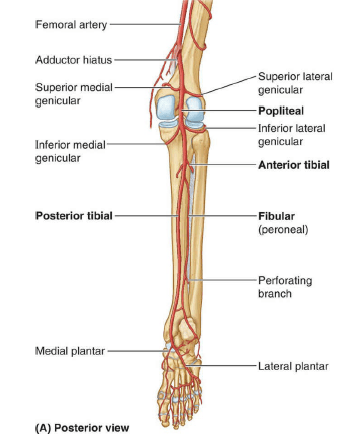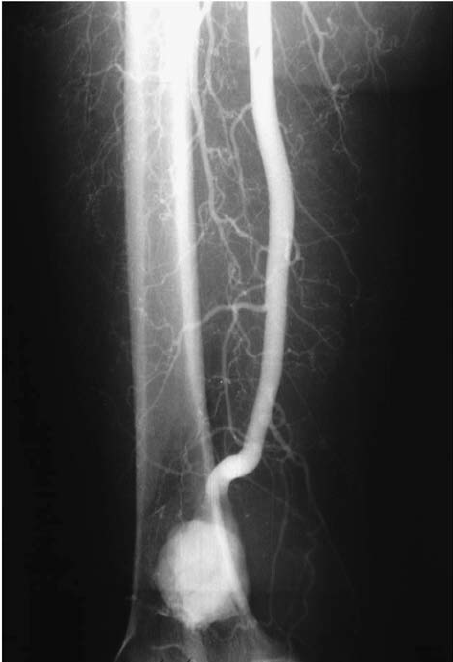Popliteal Artery Aneurysm
content of this page
1- Introduction
2- Anatomical Overview
3- Causes
4- Treatment
Introduction
A popliteal artery aneurysm (PAA) is a rare condition characterized by a weakened and bulging area in the popliteal artery, which is located behind the knee. This type of aneurysm can potentially lead to serious complications such as blood clots or rupture, which can result in limb ischemia (reduced blood flow) or even limb loss if not treated promptly.
PAAs are more common in older males and are often asymptomatic in the early stages. However, as the aneurysm grows, it can cause symptoms such as a pulsating mass behind the knee, leg pain, or numbness.

Anatomical Overview
A popliteal aneurysm (abnormal dilation of all or part of the popliteal artery) usually causes edema and pain in the popliteal fossa. A popliteal aneurysm may be distinguished from other masses by palpable pulsations (thrills) and abnormal arterial sounds (bruits) detectable with a stethoscope. Because the artery lies deep to the tibial nerve, an aneurysm may stretch the nerve or compress its blood supply (vasa vasorum). Pain from such nerve compression is usually referred, in this case to the skin overlying the medial aspect of the calf, ankle, or foot. Because the popliteal artery is closely applied to the popliteal surface of the femur and the joint capsule, fractures of the distal femur or dislocations of the knee may rupture the artery, resulting in hemorrhage. Furthermore, because of their proximity and confinement within the popliteal fossa, an injury of the artery and vein may result in an arteriovenous fistula (communication between an artery and a vein). Failure to recognize these occurrences and to act promptly may result in the loss of the leg and foot. If the femoral artery must be ligated, blood can bypass the occlusion through the genicular anastomosis and reach the popliteal artery distal to the ligation.

Causes
Atherosclerosis: The most common cause of popliteal artery aneurysms is atherosclerosis, which is the buildup of plaque in the artery walls. This can weaken the artery wall and lead to the formation of an aneurysm.
Genetics: Some individuals may have a genetic predisposition to developing aneurysms.
Inflammatory Conditions: Conditions such as vasculitis, which cause inflammation of the blood vessels, can weaken the artery walls and increase the risk of aneurysm formation.
Trauma: Injury to the popliteal artery, such as blunt trauma or a penetrating injury, can lead to the development of an aneurysm.
Infection: In rare cases, an infection of the artery wall, known as mycotic aneurysm, can cause an aneurysm to form.
Connective Tissue Disorders: Disorders that affect the connective tissue, such as Marfan syndrome or Ehlers-Danlos syndrome, can increase the risk of developing aneurysms in various blood vessels, including the popliteal artery.
Other Factors: Smoking, high blood pressure, and certain medications or medical procedures may also contribute to the development of popliteal artery aneurysms.
Treatment
Monitoring: Small, asymptomatic aneurysms may only require regular monitoring through ultrasound to check for any changes in size or condition.
Medication: Medications such as antiplatelet agents or anticoagulants may be prescribed to reduce the risk of blood clots forming within the aneurysm.
Surgery: If the aneurysm is large, growing rapidly, or causing symptoms, surgical intervention may be necessary. The main surgical options include:
Open surgery: This involves making an incision and repairing the aneurysm with a graft to reinforce the weakened artery wall.
Endovascular repair: A less invasive procedure where a stent graft is inserted through a small incision in the groin and guided to the site of the aneurysm to reinforce the artery wall from within.
Thrombosis: In some cases, especially if the aneurysm is causing symptoms due to clot formation, thrombosis (clot dissolution) may be attempted using medications or procedures like thrombolysis.
Lifestyle changes: Managing risk factors such as smoking, high blood pressure, and high cholesterol can help prevent the progression of the aneurysm and reduce the risk of complications.